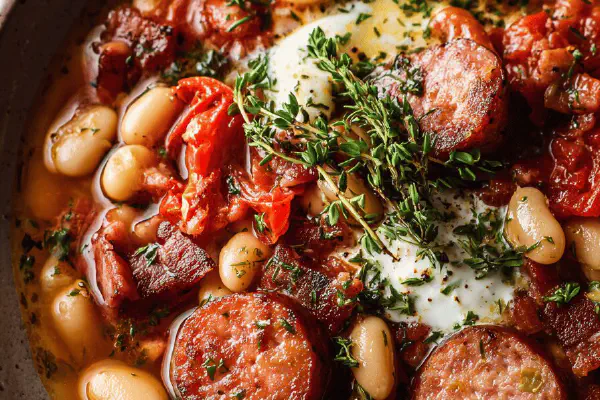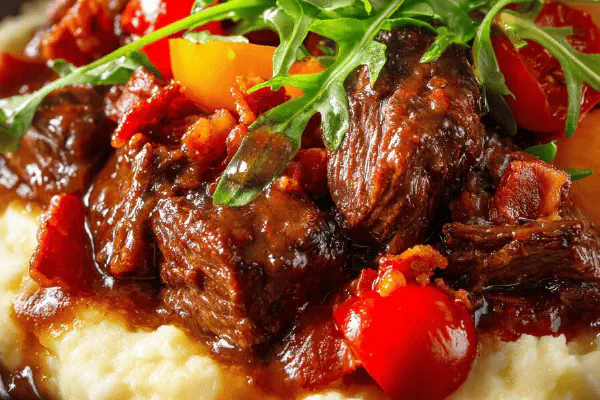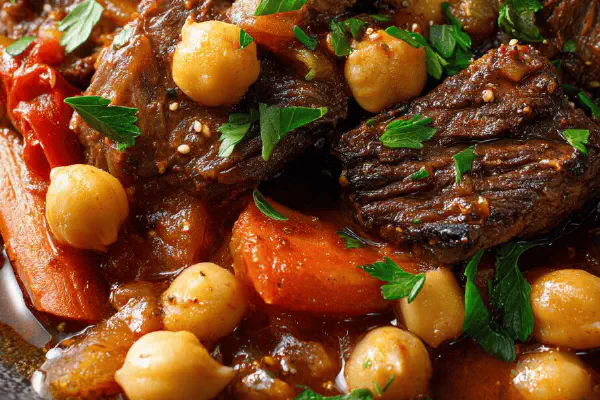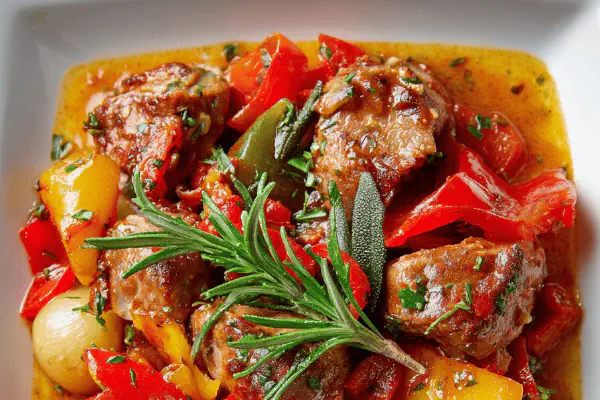Slow-Baked White Beans with Soft-Boiled Eggs
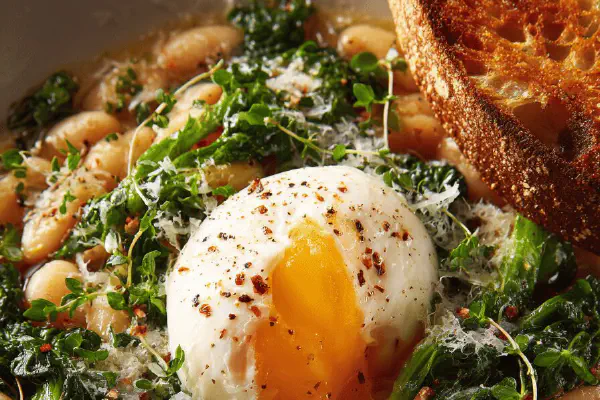
By Emma
Certified Culinary Professional
Ingredients
- 428 g dried lima beans or cannellini, rinsed and drained
- 1 medium onion, finely chopped
- 50 ml extra virgin olive oil, plus extra for serving
- 1 hard rind piece of Parmesan or pecorino cheese
- 3 sprigs fresh thyme
- 1.5 liters chicken or vegetable broth
- 2 whole garlic cloves, unpeeled
- 1/4 tsp freshly grated nutmeg
- 1/4 tsp crushed red chili flakes
- 1 lemon, finely zested
- 4 large eggs
- fleur de sel or coarse sea salt
- freshly ground black pepper
About the ingredients
Method
- Start by covering beans with cold water in a large bowl. Leave at room temperature for at least 10 hours or overnight. Beans should float but remain submerged; add water if needed. Drain well before cooking.
- Heat oven to 160°C (320°F). Position rack mid-level to allow even heat circulation around pot.
- In a heavy oven-safe casserole or Dutch oven, warm olive oil over medium heat. Sweat onion gently for about 10 minutes or until golden edges start appearing. Patience here unlocks natural sweetness and soft texture.
- Add Parmesan rind, thyme sprigs, drained beans and broth. Stir to combine. Bring just to a rolling boil on the stovetop, watch for foam scum; skim off gently with slotted spoon.
- Tuck in garlic cloves unpeeled and sprinkle nutmeg and chili flakes evenly over surface. Stir lightly and season with a pinch of salt and black pepper, restrained for now.
- Cover with lid and transfer directly to oven. Bake low and slow for 1 hour to 1 hour 10 minutes, checking beans after one hour by pressing between thumb and forefinger. They should start to soften but not burst apart entirely. Broth will thicken slightly, turning creamy and rich.
- Remove pot from oven. Let beans rest, still covered, for about 15 minutes; residual heat completes cooking without disintegrating bean skins.
- Discard Parmesan rind, thyme, and peel garlic carefully squeezing softened cloves back into beans. Taste and adjust seasoning—salt and pepper—as you see fit. The zest of lemon added earlier lifts the dish, so check if more brightness needed.
- While beans rest, bring a small saucepan of water to a gentle simmer. Not boiling hard, but active steam rising.
- Carefully lower eggs in using a spoon. Time exactly 6 minutes for soft set whites and runny yolks (mollets). Remove immediately and plunge eggs into ice-cold water for 2 minutes to halt cooking and ease peeling.
- Peel eggs under running cold water carefully to avoid tearing whites. Pat dry gently with kitchen towel.
- Serve beans warm in shallow bowls, topping each with one warm, soft-boiled egg. Drizzle liberally with more olive oil, season with cracked black pepper and a sprinkle of fleur de sel.
- Optional sides: blanched greens like spinach or chard, crusty toasted bread rub with raw garlic for dipping. Parmesan or pecorino shards add extra umami punch.
Cooking tips
Chef's notes
- 💡 Soak beans covered in cold water overnight or at least 10 hours. They should float but stay submerged; add water if needed. Drain well before cooking to avoid muddy broth and to kickstart creamy texture. Patience on soaking equals less gas later and more even cooking. Don't rush the water soak—crucial foundation.
- 💡 When sweating onions, keep heat medium-low to coax out sweetness slowly and avoid browning. Golden edges just forming is your visual cue—not too soft or burnt. The aroma around the pot changes gradually, faintly sweet and savory. That gentle soften stage sets base flavor without harsh bite creeping in.
- 💡 Low and slow baking at 160°C is essential. One hour minimum with the lid on traps steam, which cooks beans gently. Hold off stirring too much but keep skimming foam as it forms—foam contains impurities, dull taste. The starchy smell should mellow—still no mush; firm skins with creamy insides. Test with thumb and forefinger, tender but intact.
- 💡 Adding whole unpeeled garlic cloves infuses subtle mellow garlic without overpowering. The skins keep bitterness down. Squeeze softened garlic into beans once out of oven to fully release flavor. Nutmeg and chili flakes sprinkled on top early add background warmth—don’t skip even if subtle; they keep richness balanced without heat overload.
- 💡 Soft boiling eggs exactly six minutes in gentle simmer, not rapid boil, preserves delicate whites with runny yolks. Ice bath instantly stops cooking or yolks firm up. Peel under running water to minimize tearing white’s fragile texture. The timing’s tricky but sensory cues like steam intensity and descent speed mean locked-in runniness without rubbery whites.
Common questions
Can I use other beans besides lima or cannellini?
Absolutely—navy or great northern beans work but adjust soak and cook time. Larger beans need longer soak. Texture differs but layering flavors still applies. No wild swaps though; kidney beans could toughen differently.
How to make this vegan?
Swap chicken broth for vegetable stock, add splash of extra olive oil for fatty mouthfeel. Parmesan rind replaced with aged vegan rind or omit rind but add umami with dried mushrooms or miso paste. Adjust salt carefully to balance.
What if beans turn mushy?
Overcooking or rapid boil causes broken skins. Lower heat next round, check after 60 mins instead of waiting longer blindly. Constant lid on minimizes evaporation; too dry thick broth cooks beans fast and mushy. Gentle stirring needed only when skimming.
How to store leftovers?
Cool quickly, store in airtight container refrigerated up to 4 days. Reheat with splash of broth to loosen if thick. Beans freeze well but egg texture spoils so best to add fresh soft boiled eggs when serving leftovers. Bread and greens keep separate.
